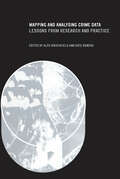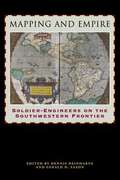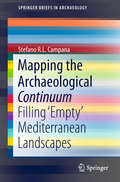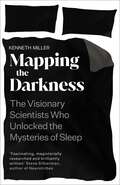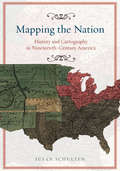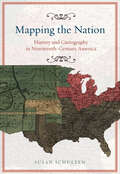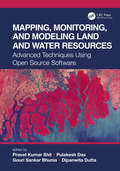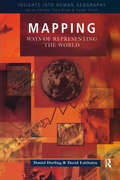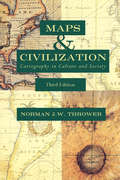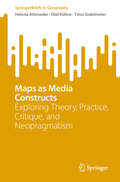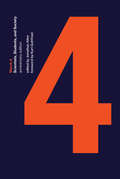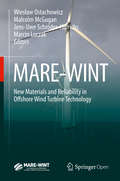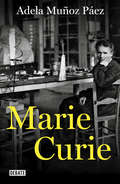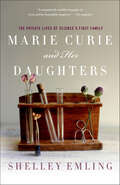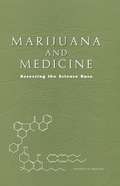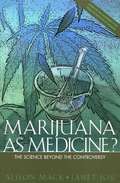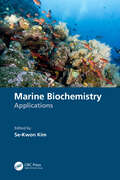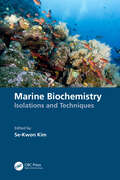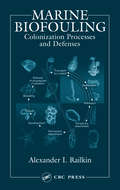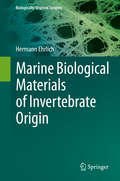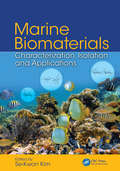- Table View
- List View
Mapping and Analysing Crime Data: Lessons from Research and Practice
by Kate Bowers Alex HirschfieldOne of the key methods of reducing and dealing with criminal activity is to accurately gauge and then analyse the geographical distribution of crime (from small scale to large scale areas). Once the police and government know what areas suffer most from criminal activity they can assess why this is the case and then deal with it in the most effecti
Mapping and Empire: Soldier-Engineers on the Southwestern Frontier
by Dennis Reinhartz Gerald D. SaxonFrom the sixteenth through the mid-nineteenth centuries, Spain, then Mexico, and finally the United States took ownership of the land from the Gulf Coast of Texas and Mexico to the Pacific Coast of Alta and Baja California—today's American Southwest. Each country faced the challenge of holding on to territory that was poorly known and sparsely settled, and each responded by sending out military mapping expeditions to set boundaries and chart topographical features.
Mapping the Archaeological Continuum: Filling 'empty' Mediterranean Landscapes (Springerbriefs In Archaeology Ser.)
by Stefano R.L. CampanaThis book addresses the true 'landscape' perspective approach that archaeologists in Italy, and in many parts of the Mediterranean, use to study the archaeology of landscapes, marking a departure from the traditional site-based approach. The aim of the book is to promote the broader application of new paradigms for landscape analysis, combining traditional approaches with multidisciplinary studies as well as comparatively new techniques such as large-scale geophysical surveying, airborne laser scanning and geo-environmental studies. This approach has yielded tangible and striking results in central Italy, clearly demonstrating that identifying the 'archaeological continuum' is a realistic aim, even under the specific environmental and archaeological conditions of the Mediterranean world.
Mapping the Chinese and Islamic Worlds
by Hyunhee ParkLong before Vasco da Gama rounded the Cape of Good Hope en route to India, the peoples of Africa, the Middle East, and Asia engaged in vigorous cross-cultural exchanges across the Indian Ocean. This book focuses on the years 700 to 1500, a period when powerful dynasties governed both regions, to document the relationship between the Islamic and Chinese worlds before the arrival of the Europeans. Through a close analysis of the maps, geographic accounts, and travelogues compiled by both Chinese and Islamic writers, the book traces the development of major contacts between people in China and the Islamic world and explores their interactions on matters as varied as diplomacy, commerce, mutual understanding, world geography, navigation, shipbuilding, and scientific exploration. When the Mongols ruled both China and Iran in the thirteenth and fourteenth centuries, their geographic understanding of each other's society increased markedly. This rich, engaging, and pioneering study offers glimpses into the worlds of Asian geographers and mapmakers, whose accumulated wisdom underpinned the celebrated voyages of European explorers like Vasco da Gama.
Mapping the Darkness: The Visionary Scientists Who Unlocked the Mysteries of Sleep
by Kenneth Miller&‘Fascinating, magisterially researched, and brilliantly written.&’ Steve Silberman, author of Neurotribes Thirty-two days underground. No heat. No sunlight. 4 June 1938. Nathaniel Kleitman and his research student make their way down the seventy-one steps leading to the mouth of Mammoth Cave. They are about to embark on one of the most intrepid and bizarre experiments in medical history, one which will change our understanding of sleep forever. Undisturbed by natural light, they will investigate what happens when you overturn one of the fundamental rhythms of the human body. Together, they enter the darkness. When Kleitman first arrived in New York, a penniless twenty-year-old refugee, few would have guessed that in just a few decades he would revolutionise the field of sleep science. In Mapping the Darkness, Kenneth Miller weaves science and history to tell the story of the outsider scientists who took sleep science from the fringes to a mainstream obsession. Reliving the spectacular experiments, technological innovation, imaginative leaps and single-minded commitment of these early pioneers, Miller provides a tantalising glimpse into the most mysterious third of our lives.
Mapping the Nation: History and Cartography in Nineteenth-Century America
by Susan SchultenIn the nineteenth century, Americans began to use maps in radically new ways. For the first time, medical men mapped diseases to understand and prevent epidemics, natural scientists mapped climate and rainfall to uncover weather patterns, educators mapped the past to foster national loyalty among students, and Northerners mapped slavery to assess the power of the South. After the Civil War, federal agencies embraced statistical and thematic mapping in order to profile the ethnic, racial, economic, moral, and physical attributes of a reunified nation. By the end of the century, Congress had authorized a national archive of maps, an explicit recognition that old maps were not relics to be discarded but unique records of the nation's past. All of these experiments involved the realization that maps were not just illustrations of data, but visual tools that were uniquely equipped to convey complex ideas and information. In Mapping the Nation, Susan Schulten charts how maps of epidemic disease, slavery, census statistics, the environment, and the past demonstrated the analytical potential of cartography, and in the process transformed the very meaning of a map. Today, statistical and thematic maps are so ubiquitous that we take for granted that data will be arranged cartographically. Whether for urban planning, public health, marketing, or political strategy, maps have become everyday tools of social organization, governance, and economics. The world we inhabit--saturated with maps and graphic information--grew out of this sea change in spatial thought and representation in the nineteenth century, when Americans learned to see themselves and their nation in new dimensions.
Mapping the Nation: History and Cartography in Nineteenth-Century America
by Susan Schulten&“A compelling read&” that reveals how maps became informational tools charting everything from epidemics to slavery (Journal of American History). In the nineteenth century, Americans began to use maps in radically new ways. For the first time, medical men mapped diseases to understand and prevent epidemics, natural scientists mapped climate and rainfall to uncover weather patterns, educators mapped the past to foster national loyalty among students, and Northerners mapped slavery to assess the power of the South. After the Civil War, federal agencies embraced statistical and thematic mapping in order to profile the ethnic, racial, economic, moral, and physical attributes of a reunified nation. By the end of the century, Congress had authorized a national archive of maps, an explicit recognition that old maps were not relics to be discarded but unique records of the nation&’s past. All of these experiments involved the realization that maps were not just illustrations of data, but visual tools that were uniquely equipped to convey complex ideas and information. In Mapping the Nation, Susan Schulten charts how maps of epidemic disease, slavery, census statistics, the environment, and the past demonstrated the analytical potential of cartography, and in the process transformed the very meaning of a map. Today, statistical and thematic maps are so ubiquitous that we take for granted that data will be arranged cartographically. Whether for urban planning, public health, marketing, or political strategy, maps have become everyday tools of social organization, governance, and economics. The world we inhabit—saturated with maps and graphic information—grew out of this sea change in spatial thought and representation in the nineteenth century, when Americans learned to see themselves and their nation in new dimensions.
Mapping the Ottomans
by Palmira Brummett"Simple paradigms of Muslim-Christian confrontation and the rise of Europe in the seventeenth century do not suffice to explain the ways in which European mapping envisioned the "Turks" in image and narrative. Rather, maps, travel accounts, compendia of knowledge, and other texts created a picture of the Ottoman Empire through a complex layering of history, ethnography, and eyewitness testimony, which juxtaposed current events to classical and biblical history; counted space in terms of peoples, routes, and fortresses; and used the land and seascapes of the map to assert ownership, declare victory, and embody imperial power's reach. Enriched throughout by examples of Ottoman self-mapping, this book examines how Ottomans and their empire were mapped in the narrative and visual imagination of early modern Europe's Christian kingdoms. The maps serve as centerpieces for discussions of early modern space, time, borders, stages of travel, information flows, invocations of authority, and cross-cultural relations"--"This book examines how the Ottomans and their empire were mapped in the narrative and visual imagination of the Christian kingdoms of early modern Europe. Simple paradigms of Muslim-Christian confrontation and the 'rise' of Europe in the seventeenth century do not suffice to explain the ways in which European mapping envisioned the "Turks" in image and narrative. Rather, maps, travel accounts, compendia of knowledge, and other texts created a picture of the Ottoman empire through a complex layering of history, ethnography, and eyewitness testimony which juxtaposed current events to classical and Biblical history; counted space in terms of peoples, routes, and fortresses; and used the land and seascapes of the map to assert ownership, declare victory, and embody the reach of imperial power. Maps here serve as centerpieces for a discussion of early modern space, time, borders, stages of travel, information flows, invocations of authority, and cross-cultural relations. The book is enriched throughout by examples of Ottoman self-mapping"--
Mapping, Monitoring, and Modeling Land and Water Resources: Advanced Techniques Using Open Source Software
by Pravat Kumar Shit, Pulakesh Das, Gouri Sankar Bhunia, and Dipanwita DuttaThe wide range of challenges in studying Earth system dynamics due to uncertainties in climate change and complex interference from human activities is creating difficulties in managing land and water resources and ensuring their sustainable use. Mapping, Monitoring, and Modeling Land and Water Resources brings together real-world case studies accurately surveyed and assessed through spatial modeling. The book focuses on the effectiveness of combining remote sensing, geographic information systems, and R. The use of open source software for different spatial modeling cases in various fields, along with the use of remote sensing and geographic information systems, will aid researchers, students, and practitioners to understand better the phenomena and the predictions by future analyses for problem-solving and decision-making.
Mapping: Ways of Representing the World (Insights Into Human Geography)
by Daniel Dorling David FairbairnIllustrates how maps tell us as much about the people and the powers which create them, as about the places they show. Presents historical and contemporary evidence of how the human urge to describe, understand and control the world is presented through the medium of mapping, together with the individual and environmental constraints of the creator of the map.
Maps and Civilization: Cartography in Culture and Society
by Thrower Norman J. W.In this concise introduction to the history of cartography, Norman J. W. Thrower charts the intimate links between maps and history from antiquity to the present day. A wealth of illustrations, including the oldest known map and contemporary examples made using Geographical Information Systems (GIS), illuminate the many ways in which various human cultures have interpreted spatial relationships. The third edition of Maps and Civilization incorporates numerous revisions, features new material throughout the book, and includes a new alphabetized bibliography.
Maps as Media Constructs: Exploring Theory, Practice, Critique, and Neopragmatism (SpringerBriefs in Geography)
by Olaf Kühne Timo Sedelmeier Helena AttenederThis book fills a gap in the market by taking an introductory look at cartographic representations as multimedia constructs, from theory to critique to neopragmatist perspectives and in practice. It offers an interdisciplinary analysis from the fields of media and communication studies as well as geography and cartography to examine how cartographic representations as constructions of multimedia shape our options for appropriating space and possessing space-generating qualities. Examples from current social discourses such as the COVID-19 pandemic, debates on climate change, and sustainability plus the war in Ukraine show how multimedia cartographic representations are part of the communicative negotiation processes in public media spheres. The book offers insights into the theoretical foundations, historical developments, and practical applications of cartography, with a particular focus on the critical reflection of power structures and interests. It is aimed at students, researchers, and teachers, thereby inviting each to understand maps not only as technical artifacts but also as complex multimedia constructions.
March 4, anniversary edition: Scientists, Students, and Society (The\mit Press Ser.)
by Jonathan AllenScientists debate the role of scientific research in the military-industrial complex and consider the complicity of academic science in American wars.On March 4, 1969, MIT faculty and students joined together for an extraordinary day of protest. Growing out of the MIT community's anguish over the Vietnam War and concern over the perceived complicity of academic science with the American war machine, the events of March 4 and the days following were a “positive protest”—a forum not only for addressing political and moral priorities but also for mapping out a course of action. Soon afterward, some of the participants founded the Union of Concerned Scientists. This book documents the March 4 protest with transcripts of talks and panel discussions. Speakers included Noam Chomsky, Howard Zinn, Lionel Trilling, and Nobel Laureate George Wald, whose memorable speech, “A Generation in Search of a Future,” was widely circulated. Topics of discussion ranged from general considerations of the intellectuals' political responsibility to specific comments on the Vietnam War and nuclear disarmament. This fiftieth anniversary edition adds a foreword by Kurt Gottfried, a physicist, participant in the March 4 protest, and cofounder of the Union of Concerned Scientists. He writes, forcefully and hopefully, “Fifty years ago, a remarkable awakening was occurring among American scientists about their role in society. This volume offers a fascinating snapshot of that moment on March 4, 1969, and the activities and discussions collected here remain relevant and resonant today.” In an era when many politicians routinely devalue science, we can take inspiration from the March 4 protests.
Mare-wint
by Wiesław Ostachowicz Malcolm Mcgugan Jens-Uwe Schröder-Hinrichs Marcin LuczakThis book provides a holistic, interdisciplinary overview of offshore wind energy, and is a must-read for advanced researchers. Topics, from the design and analysis of future turbines, to the decommissioning of wind farms, are covered. The scope of the work ranges from analytical, numerical and experimental advancements in structural and fluid mechanics, to novel developments in risk, safety & reliability engineering for offshore wind. The core objective of the current work is to make offshore wind energy more competitive, by improving the reliability, and operations and maintenance (O&M) strategies of wind turbines. The research was carried out under the auspices of the EU-funded project, MARE-WINT. The project provided a unique opportunity for a group of researchers to work closely together, undergo multidisciplinary doctoral training, and conduct research in the area of offshore wind energy generation. Contributions from expert, external authors are also included, and the complete work seeks to bridge the gap between research and a rapidly-evolving industry.
Marie Curie
by Adela Muñoz PáezLa historia oculta de Marie Curie, la madre de la física moderna. Todos creemos saber quién fue Marie Sklodowska. También conocida como Marie Curie, fue la primera mujer en recibir un premio Nobel y la primera mujer científica en ser reconocida universalmente: su descubrimiento de la radioactividad fue el inicio de una brillante carrera que culminó con la incorporación de dos nuevos elementos a la tabla periódica. Trabajadora incansable, Marie Curie vivió aparentemente ajena a las limitaciones impuestas a las mujeres de su tiempo. La realidad, sin embargo, es que fue denostada y agredida: la tildaron de impostora, de judía inmigrante, de adúltera, de aprovechada... Esta apasionante biografía nos hará descubrir con nuevos ojos la vida de una científica extraordinaria que, todavía hoy, sigue suscitando una inmensa fascinación.
Marie Curie and Her Daughters: The Private Lives of Science's First Family
by Shelley EmlingPublished to widespread acclaim, in Marie Curie and Her Daughters, science writer Shelley Emling shows that far from a shy introvert toiling away in her laboratory, the famed scientist and two-time Nobel prize winner was nothing short of an iconoclast. Emling draws on personal letters released by Curie's only granddaughter to show how Marie influenced her daughters yet let them blaze their own paths: Irene followed her mother's footsteps into science and was instrumental in the discovery of nuclear fission; Eve traveled the world as a foreign correspondent and then moved on to humanitarian missions. Emling also shows how Curie, following World War I, turned to America for help. Few people know about Curie's close friendship with American journalist Missy Meloney, who arranged speaking tours across the country for Marie, Eve, and Irene. Months on the road, charming audiences both large and small, endeared the Curies to American women and established a lifelong relationship with the United States that formed one of the strongest connections of Marie's life.Factually rich, personal, and original, this is an engrossing story about the most famous woman in science that rips the cover off the myth and reveals the real person, friend, and mother behind it.
Marijuana and Medicine: Assessing the Science Base
by Institute of MedicineThe medical use of marijuana is surrounded by a cloud of social, political, and religious controversy, which obscures the facts that should be considered in the debate.This book summarizes what we know about marijuana from evidence-based medicine--the harm it may do and the relief it may bring to patients. The book helps the reader understand not only what science has to say about medical marijuana but also the logic behind the scientific conclusions.Marijuana and Medicine addresses the science base and the therapeutic effects of marijuana use for medical conditions such as glaucoma and multiple sclerosis. It covers marijuana's mechanism of action, acute and chronic effects on health and behavior, potential adverse effects, efficacy of different delivery systems, analysis of the data about marijuana as a gateway drug, and the prospects for developing cannabinoid drugs. The book evaluates how well marijuana meets accepted standards for medicine and considers the conclusions of other blue-ribbon panels.Full of useful facts, this volume will be important to anyone interested in informed debate about the medical use of marijuana: advocates and opponents as well as policymakers, regulators, and health care providers.
Marijuana as Medicine? The Science Beyond the Controversy
by Alison MackSome people suffer from chronic, debilitating disorders for which no conventional treatment brings relief. Can marijuana ease their symptoms? Would it be breaking the law to turn to marijuana as a medication? There are few sources of objective, scientifically sound advice for people in this situation. Most books about marijuana and medicine attempt to promote the views of advocates or opponents. To fill the gap between these extremes, authors Alison Mack and Janet Joy have extracted critical findings from a recent Institute of Medicine study on this important issue, interpreting them for a general audience. Marijuana As Medicine? provides patients--as well as the people who care for them--with a foundation for making decisions about their own health care. This empowering volume examines several key points, including: Whether marijuana can relieve a variety of symptoms, including pain, muscle spasticity, nausea, and appetite loss. The dangers of smoking marijuana, as well as the effects of its active chemical components on the immune system and on psychological health. The potential use of marijuana-based medications on symptoms of AIDS, cancer, multiple sclerosis, and several other specific disorders, in comparison with existing treatments. Marijuana As Medicine? introduces readers to the active compounds in marijuana. These include the principal ingredient in Marinol, a legal medication. The authors also discuss the prospects for developing other drugs derived from marijuana's active ingredients. In addition to providing an up-to-date review of the science behind the medical marijuana debate, Mack and Joy also answer common questions about the legal status of marijuana, explaining the conflict between state and federal law regarding its medical use. Intended primarily as an aid to patients and caregivers, this book objectively presents critical information so that it can be used to make responsible health care decisions. Marijuana As Medicine? will also be a valuable resource for policymakers, health care providers, patient counselors, medical faculty and students--in short, anyone who wants to learn more about this important issue.
Marine Biochemistry: Applications
by Se-Kwon KimThis book provides the latest comprehensive methods for isolation and other novel techniques for marine product development. Furthermore, this book offers knowledge on the biological, medical, and industrial applications of marine-derived medicinal food substances. There has been a tremendous increase in the products derived from marine organisms for commercial application in industries every year. Functional foods of medicinal value are particularly in demand as new technology allows the stabilization of natural ingredients and their availability in pure forms to solve various human diseases. Marine flora and fauna have essential elements and trace minerals that nurture various hormones produced in the endocrine system to regulate the respective metabolisms, thereby providing a safe and healthy life to humans. The overall presentation and clear demarcation of the contents by worldwide contributions is a novel entry point into the market of medicinal foods from the sea. The exploration of marine habitats for novel materials are discussed throughout the book. The exploration and exploitation of the biochemistry of sea flora and fauna are limited, and this book extends the research possibilities into numerous marine habitats. Various approaches for extracting and applying the flora and fauna are discussed. This book will be of value to researchers, marine biotechnologists, and medical practitioners, due to the vast information, as well as industrial and medical applications of marine substances all in one place.
Marine Biochemistry: Isolations and Techniques
by Se-Kwon KimThis book provides the latest comprehensive methods for isolation and other novel techniques for marine product development. Furthermore, this book offers knowledge on the biological, medical, and industrial applications of marine-derived medicinal food substances. There has been a tremendous increase in the products derived from marine organisms for commercial application in industries every year. Functional foods of medicinal value are particularly in demand as new technology allows the stabilization of natural ingredients and their availability in pure forms to solve various human diseases. Marine flora and fauna have essential elements and trace minerals that nurture various hormones produced in the endocrine system to regulate the respective metabolisms, thereby providing a safe and healthy life to humans. The overall presentation and clear demarcation of the contents by worldwide contributions is a novel entry point into the market of medicinal foods from the sea. The exploration of marine habitats for novel materials are discussed throughout the book. The exploration and exploitation of the biochemistry of sea flora and fauna are limited, and this book extends the research possibilities into numerous marine habitats. Various approaches for extracting and applying the flora and fauna are discussed. This book will be of value to researchers, marine biotechnologists, and medical practitioners, due to the vast information, as well as industrial and medical applications of marine substances all in one place.
Marine Bioenergy: Trends and Developments
by Se-Kwon Kim Choul-Gyun LeeMarine Bioenergy: Trends and Developments features the latest findings of leading scientists from around the world. Addressing the key aspects of marine bioenergy, this state-of-the-art text:Offers an introduction to marine bioenergyExplores marine algae as a source of bioenergyDescribes biotechnological techniques for biofuel productionExplains th
Marine Biofouling: Colonization Processes and Defenses
by Alexander I. RailkinRecent instances of bioinvasion, such as the emergence of the zebra mussel in the American Great Lakes, generated a demand among marine biologists and ecologists for groundbreaking new references that detail how organisms colonize hard substrates, and how to prevent damaging biomass concentrations.Marine Biofouling: Colonization Processes a
Marine Biological Materials of Invertebrate Origin: Invertebrates (Biologically-Inspired Systems #13)
by Hermann EhrlichThe work is a source of modern knowledge on biomineralization, biomimetics and bioinspired materials science with respect to marine invertebrates. The author gives the most coherent analysis of the nature, origin and evolution of biocomposites and biopolymers isolated from and observed in the broad diversity of marine invertebrate organisms and within their unusual structural formations. The basic format is that of a major review article, with liberal use of references to original literature. There is a wealth of new and newly synthesized information, including dozens of previously unpublished images of unique marine creatures and structures from nano- to microscale including high-resolution scanning and transmission electron micrographs. The material is organized effectively along both biological (phyla) and functional lines. The classification of biological materials of marine origin is proposed and discussed. Much of the pertinent data is organized into tables, and extensive use is made of electron micrographs and line drawings. Several modern topics e.g. “biomineralization- demineralization-remineralization phenomena”, or “phenomenon of multiphase biomineralization”, are discussed in details. Traditionally, such current concepts as hierarchical organization of biocomposites and skeletal structures, structural bioscaffolds, biosculpturing, biomimetism and bioinspiration as tools for the design of innovative materials are critically analyzed from both biological and materials science point of view using numerous unique examples of marine origin. This monograph reviews the most relevant advances in the marine biomaterials research field, pointing out several approaches being introduced and explored by distinct laboratories.
Marine Biomaterials: Characterization, Isolation and Applications
by Se-Kwon KimOceans are an abundant source of diverse biomaterials with potential for an array of uses. Marine Biomaterials: Characterization, Isolation and Applications brings together the wide range of research in this important area, including the latest developments and applications, from preliminary research to clinical trials. The book is divided into fou
